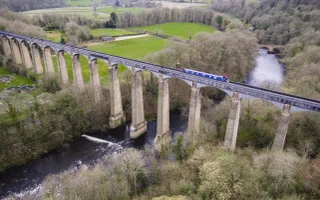Demand
The demand for long-term moorings derives directly from the increase in popularity of inland waterway boat ownership. Approximately 95% of owners of powered craft on our waterways require a long-term mooring, with the remaining 5% cruising around the network continuously and not staying in any one place for any length of time.
The Association of Inland Navigation Authorities (AINA) collates annual data from the leading navigation authorities that together show the national picture across the waterway network as a whole. We have collected data from 1992 to identify trends in boats we license annually.
The main influences on demand for moorings at a specific new site are as follows.
- The choice and attractiveness of cruising routes from the proposed site. We generate a proxy measure of boat traffic by means of lock counters. These record the number of times that a lock fills with water and gives an indication of the relative usage of different waterway stretches (the boat:lockage ratio averages up to 1.5 for narrow locks and 1.9 for wide locks).
- The size and projected growth of the local boat owner market. Defining the market is an important first step. As a rule of thumb, around three out of four of all boat owners choose a mooring within 40 miles of their home. The demographic profile of the population within the catchment will have a significant bearing on demand: boat ownership is heavily concentrated amongst older, higher income households. The national penetration rate of the boat owners we license is approximately 0.4 boat owners per thousand population, but this rises to nearly 2.5 owners per thousand amongst people aged 45-64 and living within 10km of one of our canals or rivers.
- The size and character of the competition for your site. We publish information about existing mooring sites on our website. This will identify existing mooring sites in the vicinity of your site and may also include details of mooring rates and facilities.
- The extent to which existing mooring and marina provision meets current and projected future demand. Mooring sites are differentiated primarily according to scale of facilities. Customer preferences for different levels of services vary. One important factor for most boaters is good security. The more facilities you provide, the higher the mooring fee you'll be able to achieve. Recent years have seen a reduction in small boatyards. As a result, you may find significant demand for ancillary services such as slipways, dry and/or wet docks, and services for boats passing by or wishing to stay for a short period.
Residential moorings
A significant consideration will be whether to provide berths for residential boats. There is strong demand for residential moorings in some locations. They have a different impact on local communities than pleasure boats and will require specific planning permission. Early discussions with the local planning authority on this aspect should avoid difficulties once your scheme is submitted for approval.
Residential moorings may also raise issues relating to council tax. Most leisure marina operators find that random mixing of residential and leisure berths can create operational difficulties, so some zoning within the site that takes account of the differing needs of the two groups is worth considering.
Visitor moorings
There are few paid-for visitor moorings on our network in England and Wales, but there is growing evidence of demand for more sophisticated services and security at popular destinations. Boaters are free to tie up almost anywhere along the towpath for short periods, and many enjoy peaceful, remote moorings with no facilities in the countryside.
However, where demand regularly outstrips the space available at popular visitor moorings, we make a charge and/or restrict the length of time a boater may stay there. Depending on the location of your mooring site, you might be able to capture a share of the emerging market for superior overnight or short-stay facilities.
Creating a destination
We encourage you to consider creating a destination on the waterway for a broad range of visitors, not just a place for boats to moor. Attracting the public onto your site with opportunities such as retail, catering and leisure pursuits (e.g. boat or bike hire to explore the wider area) can provide additional revenue and stimulate interest in your moorings.
There may be opportunities to capture a share of the passing boater market by making your services and facilities available to them as well as your long-term moorers. Contact our local waterway office to see if there are opportunities to provide essential boater services such as water, refuse disposal, elsan/pump-out, etc.



